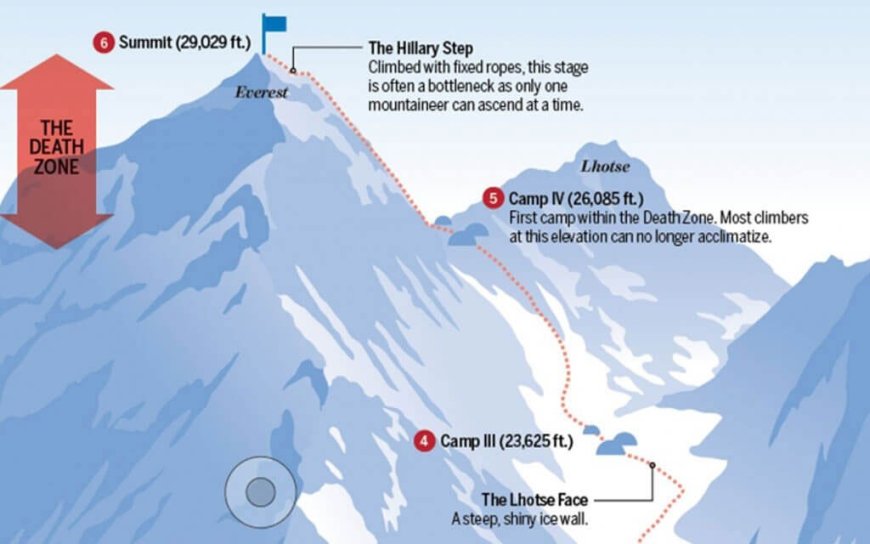Climbing Mt Everest: Ksh13M Costs, Risks & Why Bodies Cannot Be Recovered
Climbing Mt Everest is considered by many as the ultimate human test as you not only have to encounter brutal challenges such as altitude sickness, weather and snow avalanches from the Khumbu Icefall but also time, altitude adjustment, the right gear, wait for the right weather and of course money.

The death of Kenyan banker Cheruiyot Kirui during his pursuit to summit Mount Everest without supplemental oxygen brought to light the dangers associated with attempting a treacherous expedition.
Kirui wanted to reach the world’s highest mountain summit (8,848.86 meters above sea level) without supplementary oxygen, defying the increased risks that come with it compared to climbing it with supplementary oxygen.
He went missing on Wednesday with his guide, a Nepali climber identified as Nawang Sherpa, on Wednesday, at Bishop Rock, located at an altitude of 8,000 metres. However, his body was found a few metres below the Everest summit point, as announced on Thursday morning by the Nepali mountaineering news website Everest Today.
Climbing Mt Everest is considered by many as the ultimate human test as you not only have to encounter brutal challenges such as altitude sickness, weather and snow avalanches from the Khumbu Icefall but also time, altitude adjustment, the right gear, wait for the right weather and of course money.

Kenyan banker Cheruiyot Kirui posing in front of his gear before climbing Mt Everest. /CHERUIYOT KIRUI
Summiting it requires a lot of experience in mountaineering elsewhere, a certificate of good health, equipment and a trained Nepalese guide. This is because the snow and ice on the mountain create deadly hazards, such as avalanches, and there is only a limited climbing season due to bad weather conditions.
At 8,849 metres, Everest’s summit has approximately one-third the air pressure that exists at sea level, and this is the altitude that puts a person metres below the cruising altitude of passenger aircraft.
This significantly reduces a climber's ability to breathe in enough oxygen. Because of this, scientists have determined that the human body is not capable of remaining indefinitely above 6,000 metres.
The chances of success are much less than when climbing without supplemental oxygen, and with a less than 40 per cent success rate, one needs to be extremely fit, compared to a success rate of almost 80 per cent with supplemental oxygen.
The Death Zone
Climbers who ascend higher than 8,000 metres on Mount Everest enter the "death zone". In this area, oxygen is so limited that the body's cells start to die, and judgment becomes impaired.
“There, your body is not structured to survive with that oxygen concentration, which is around a third of what is at sea level. The idea is that when you are there, you get to the summit as fast as possible and then down before your body starts shutting down or dying, so to speak,” the late Kirui stated in a past interview.
“That is the area where people use supplemental oxygen. If you have it, then you're compensating for the low oxygen in the environment by using the bottled oxygen.”
According to news media agencies, 310 people died in November 2022 while attempting to climb the mountain. It further says more than 200 bodies are still on the mountain and have not been removed due to the dangerous conditions.
Experts say if you try to climb Everest, you have about a one in a hundred chance of dying along the way. This is attributed to technology and infrastructure that have brought down the number of deaths.

A description of the death zone on Mt Everest. /PHOTO
The majority of deaths are caused by snowfall avalanches. But as climbers move higher up the mountain and their oxygen intake is reduced, their bodies are increasingly at risk for a number of ailments, including pulmonary oedema, cerebral oedema, and blood embolisms, National Geographic explains.
The chances of frostbite are also dramatically increased at such altitude as the heart works harder to pump blood around the body delivering oxygen.
“Furthermore, breathing “gas” only increases the relative oxygen to about the same level as the air at basecamp, and if it runs out on summit day, the body might not be able to adapt to the sudden lack of oxygen. Lastly, oxygen units are notoriously unreliable,” it says.
Why Bodies Can't Be Recovered From Everest
Recovering a body from Mt Everest's peak is a massive logistical challenge, requiring a well-coordinated team of climbers and specialised equipment, a process can take days or even weeks, depending on the body's location and the mountain's conditions. Each additional person and piece of equipment increases the mission's risk and complexity.
The extremely cold temperatures on Everest help preserve bodies, preventing decomposition. Subzero conditions, often reaching as low as -60 degrees Celsius (-76 degrees Fahrenheit), ensure preservation for many years, with bodies remaining almost perfectly intact decades after climbers' deaths.
Despite the danger of recovering the bodies of those who die on Mt Everest, some are still recovered although at an expensive cost which can vary widely depending on factors such as the location of the body, the availability of skilled personnel, and the equipment required for the mission. The range as of 2016 was estimated to cost between Ksh3.975 million ($30,000) and Ksh9.3 million ($70,000).
Helicopters
While helicopters are commonly used in search and rescue operations in mountainous regions, they are not a feasible option for recovering bodies from the death zone of Mt. Everest. This is because of:
- Altitude: Helicopters struggle to operate effectively at the extreme altitudes found on Everest. The thin air makes it difficult for helicopters to generate lift, reducing their carrying capacity and range.
- Temperature: The bitterly cold temperatures on Everest can cause helicopter engines to malfunction or freeze, posing a significant risk to both the aircraft and the crew.
- Wind: High winds are common on Everest, especially in the death zone, making helicopter operations even more hazardous. Strong gusts can buffet helicopters, making it challenging to maintain control and stability.
- Limited Landing Sites: The rugged terrain and lack of suitable landing sites in the death zone further complicate helicopter operations. Pilots must contend with narrow ridges, steep slopes, and crevasses, making it nearly impossible to land safely.
Alternative recovery methods
Given the limitations of helicopters, alternative methods are often employed to recover bodies from Mt. Everest. These may include:
- Sherpa teams: Experienced Sherpa climbers are often enlisted to retrieve bodies from high-altitude locations. Their expertise in navigating the mountain's terrain and their resilience to the harsh conditions make them invaluable assets in recovery efforts.
- Manual carrying: In some cases, bodies may be manually carried down from the death zone by teams of climbers. This arduous process involves securing the body in a stretcher or harness and carefully descending the mountain while avoiding hazards such as crevasses and avalanches.
- Airlifts from lower altitudes: Helicopters may be used to airlift bodies from lower altitudes, where the air is denser and conditions are less extreme. However, this approach is limited by the altitude at which helicopters can safely operate and may not be feasible for bodies located in the death zone.
Relocation of bodies on Mt. Everest
Glacial movement and avalanches can relocate bodies from their original locations, carrying them to lower altitudes or different areas of the mountain.
Bodies may reappear years after being lost due to glacial movement. Despite preservation by cold, bodies are still subject to natural elements.

Climbers on Mt Everest. /FILE
High winds, ice, and snow can gradually erode and damage bodies over time, along with clothing and equipment.
The Climb
There are two base camps on Mount Everest, on opposite sides of the mountains: South Base Camp is in Nepal at an altitude of 5,364 metres (17,598 ft) (28°0′26″N 86°51′34″E), while North Base Camp is in China at 5,150 metres (16,900 ft) ( 28°8′29″N 86°51′5″E).
The camps are used by mountaineers to climb during their ascent and descent. Supplies are also shipped by porters and with the help of animals. Mountaineers acclimatise in these camps to reduce the risk of altitude sickness.
For perspective, Kenya’s highest mountain, Mount Kenya stands at 5,199 metres above sea level, while the summit of Kilimanjaro, Africa’s tallest mountain is at 5,895 metres high.
Everest's two base camps; the South Base Camp in Nepal at an altitude of 5,364 metres and the North Base Camp in Tibet at 5,150 metres. Its lowest camp is just 49 metres short of the height of Kenya’s highest point.
The Cost
Climbing Mt Everest can cost you an arm and a leg. Climbers pay anything from $35,000 (Ksh4.9 million) to more than $100,000 (Ksh13 million).
The cost includes $11,000 (Ksh1.4 million) for the climbing permit from the government of Nepal or Tibet, bottled oxygen and high-altitude gear that includes tents, sleeping bags and boots. It also covers medical care, food and support from Sherpa guides and bottled oxygen for them, which is mandatory for every foreign climber.
Most climbing of Everest and the Himalayas is done in April and May when weather conditions are most favourable. It is a tedious process which requires months, sometimes years, of training and conditioning as Everest climbers have to go through an acclimatisation process to adjust their lungs to the thinning oxygen levels once they arrive on the mountain.
According to CNN Travel, this involves travelling upward to one of the four designated camps on the mountain and spending one to four days there before travelling back down. Climbers repeat this routine at least two times for their bodies to adapt to declining oxygen levels and increase their chances of survival and summiting.
There have been 11,996 total Everest summits from 1922 to 2023, according to the Himalayan Database, which compiles records of all expeditions in the Himalayas. Today, many ethnic groups guide tourists to the mountain and carry loads of supplies up the mountain. The Sherpas tribe from Tibet used to be the only tribe but today multiple ethnic groups earn a living by leading climbers.
The Summit
When you finally reach the summit, you will find a small dome of snow about the size of a dining room table. That is because the summit has enough space for half a dozen or so climbers to stand and enjoy the view.







